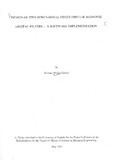| dc.description.abstract | A Turbo-Pascal program is written to design circularly-symmetric,
2-Dimensional, finite impulse response (FIR) digital filters
using the Kaiser window method.
The filter specifications are given in the frequency domain and
comprise the passband limit (s), the transition width (s) and the
ripple. Given these specifications, the first approximations of
the window order and window parameter (0:) are computed using
expressions given by T.S. Speake and R.M. Mersereau [20].
The operation of inverse discrete Fourier transform (IDFT) is
used to obtain the ideal impulse response. The window function
and the ideal impulse response are then multiplied point by point
to get the actual impulse response. The DFT operation is then
performed to get the Forier transform at discrete points in
space.
The filter characteristics of the designed filter are made
available n tabular forms once the frequency response is
determined. This enables the user to compare them with the
supplied specifications. If the user is satisfied with the
designed filter, then he/she can have the filter impulse response
in the form of tables or 3-dimensional graphs. If, on the other
hand, the filter specifications are not met and the user wants to
redesign the filter, he/she can supply new values for the window
order and window parameter (a). Increasing the window parameter (a)
has the effect of reducing the ripple but widening the transition
width. With the new values of the window order and parameter (a),
the filter is redesigned. The process can be repeated as many
times as one wishes until the user is satisfied with the design.
The 3-dimensional graphs can be printed on paper if the user so
wishes.
For most lowpass filter applications, a redesign of the filter is
not required as the first round design produces filters that meet
the specifications. For other types, however, redesigns are often
required especially if the window order is low.
Coded data for 65x65 images with 32 gray levels are used as input
data for the image processing application. An image is displayed
on the screen with 16 gray leveis (actual gray levels divided by ...
2).
The image is then corrupted by impulse noise with 10% probability
and displayed on the screen.
The effect of the different standard filters on both the original
image and the image corrupted with noise can then be studied by
designing the required filters and filtering the images with
these filters. To effect all these, one only needs to respond
appropriately to prompts from the computer.
The blurring effects of the lowpass filter can best be studied by
applying it to an image corrupted with impulse noise while the
edge sharpening effect of highpass filters can best be seen when
applied to the original uncorrupted image. | en |

